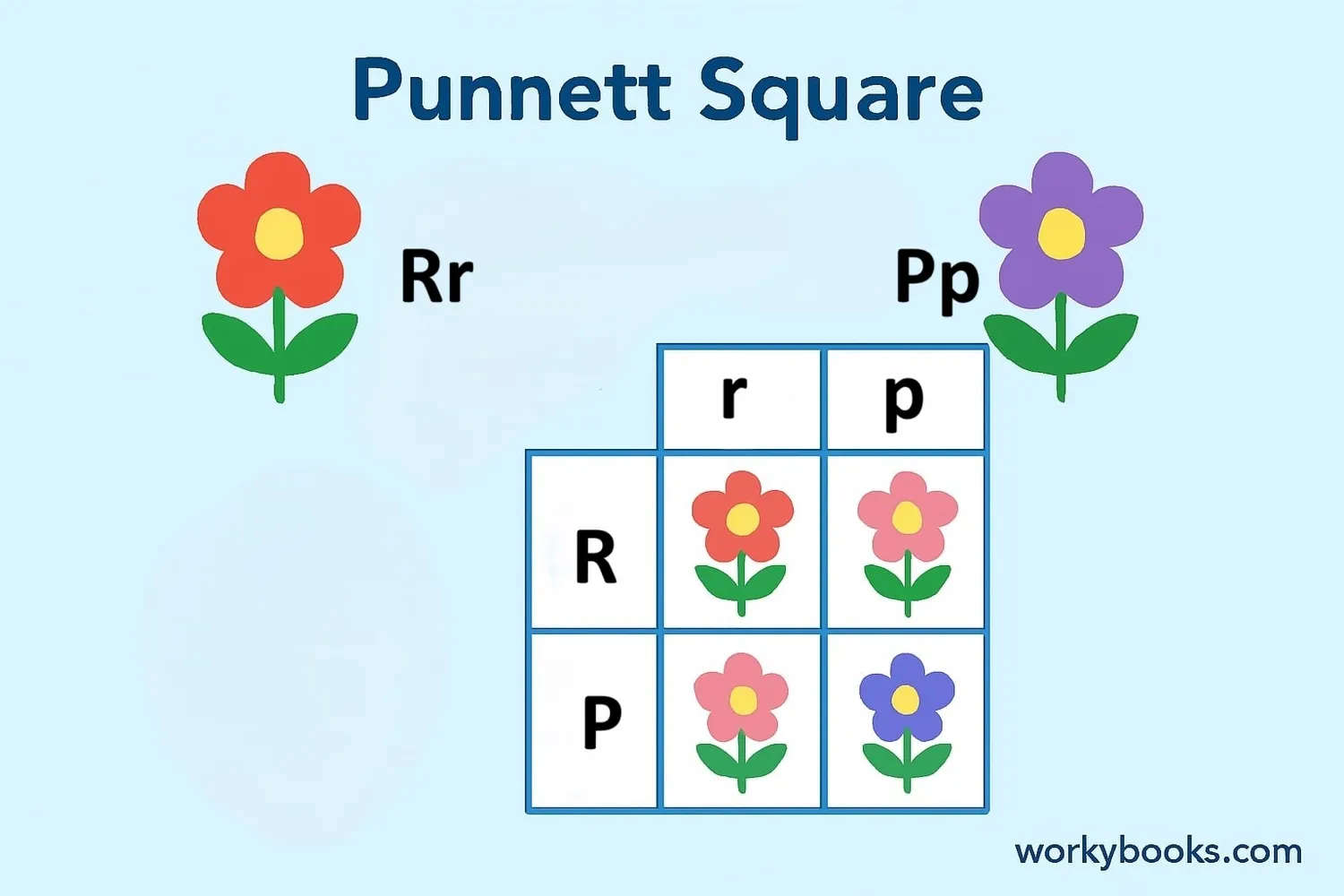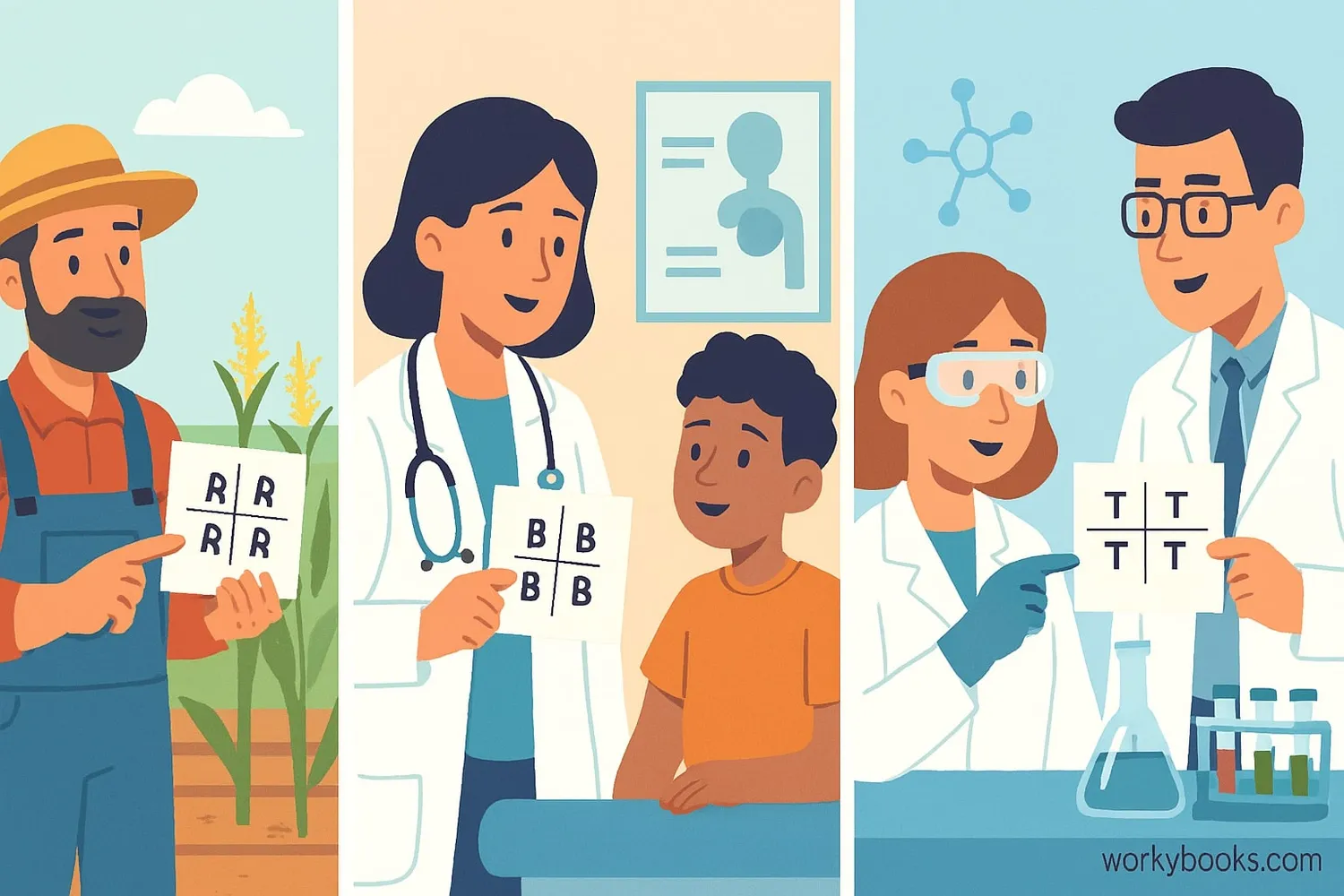Punnett Squares - Definition, Examples, Quiz, FAQ, Trivia
Learn how to predict traits using genetics and simple diagrams!
What are Punnett Squares?

A Punnett square is a special diagram that helps us predict the possible genetic combinations when two parents pass their genes to their offspring. It's named after Reginald Punnett, a British geneticist who developed this method in 1905.
Think of a Punnett square as a grid that shows all the possible ways genes from parents can combine. Each parent contributes one version of a gene (called an allele) for each trait. The Punnett square helps us see what combinations might happen and how likely each combination is.
Key terms:
• Genotype: The genetic makeup (like BB, Bb, or bb)
• Phenotype: The physical appearance (like brown eyes or blue eyes)
• Dominant allele: A version of a gene that shows its trait even if only one copy is present (shown with capital letters)
• Recessive allele: A version of a gene that only shows its trait when two copies are present (shown with lowercase letters)
Genetics Fact!
Every person has about 20,000-25,000 genes, and Punnett squares help us understand how these genes combine!
How to Use Punnett Squares
Creating a Punnett square is like solving a genetic puzzle! Follow these steps:
Identify Parents
Determine the genotypes of both parents for the trait you're studying
Set Up Grid
Draw a 2x2 square (for one trait)
Label Rows/Columns
Write one parent's alleles on top and the other on the side
Fill in Boxes
Combine the alleles from each row and column
Calculate Odds
Determine probabilities for each genotype and phenotype
Let's try an example with eye color:
Parent 1: Brown eyes (Bb) - heterozygous
Parent 2: Blue eyes (bb) - homozygous recessive
Results:
• 50% chance of Bb (brown eyes)
• 50% chance of bb (blue eyes)
Punnett Square Examples
Punnett squares can help predict traits for plants, animals, and humans. Here are some common examples:
Plant Flower Color
Purple (PP or Pp) vs. White (pp)
Pp x Pp → 75% purple
Human Dimples
Dimples (DD or Dd) vs. No dimples (dd)
DD x dd → all dimples
Animal Fur Color
Black (BB) vs. White (bb)
Bb x Bb → 75% black
Dihybrid Crosses: Punnett squares can also predict two traits at once! For example, we can look at both seed color and seed shape in peas. This requires a 4x4 grid with 16 possible combinations.
Probability Fact!
While Punnett squares show probabilities, real genetic outcomes follow the laws of chance, like flipping coins!
Why Punnett Squares are Important

Punnett squares are more than just classroom tools - they have real-world importance:
Agriculture
Farmers use them to breed plants and animals with desirable traits
Medicine
Doctors predict genetic disorder risks in families
Research
Scientists understand inheritance patterns in biology
Punnett squares help us understand:
• How traits are passed through generations
• Why family members look similar
• How genetic diversity occurs
• Why some traits skip generations
They provide a visual way to understand probability in genetics and are fundamental to modern biology!
Punnett Squares Quiz
Test your genetics knowledge with this Punnett squares quiz! Answer all 5 questions to see how much you've learned.
Frequently Asked Questions
Here are answers to common questions about Punnett squares:
Fun Genetics Trivia
Discover some amazing facts about genetics and Punnett squares!
Historical Origins
Gregor Mendel, the "father of genetics," discovered inheritance patterns using pea plants in the 1860s, decades before Punnett squares were created!
Human Genetics
Most human traits are controlled by multiple genes, not just one. That's why Punnett squares are simplified models of complex genetic realities.
Animal Breeding
Dog breeders use Punnett squares to predict coat colors and patterns. Some coat colors require specific combinations of multiple genes!
Plant Science
Modern corn is the result of thousands of years of selective breeding. Today's geneticists still use Punnett principles to develop better crops.


